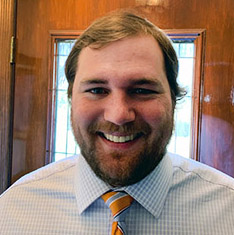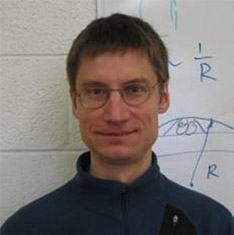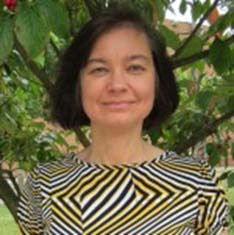Understanding the Great Divide
Bacteria, through no fault of their own, often have a public relations problem. People are quick to see them as a cause for illness. Soaps, hand sanitizers, and cleaning products are marketed on the promise of eliminating them. Yet any one person’s digestive system can have up to 100 trillion bacteria comprising a mix of mostly good and some not-so-good characters. Most strains of Escherichia coli (E. coli) —like those in the human digestive tract—are safe and even helpful. Understanding how these cells divide can help develop better antibiotics, provide a blueprint for synthesized enzymes, and tell scientists more about how phase transitions occur—a fundamental concept in physics.
UT’s biophysicists have used high-resolution imaging tools to get a clearer picture of what prompts these bacterial cells to split in two. They published the findings in the February 3 issue of Current Biology. Bryant Walker, a physics graduate student, is the lead author, joined by Associate Professor Jaan Männik and Research Scientist Jaana Männik.



Bryant Walker, Jaan Männik, and Jaana Männik.
There are certain principles of E. coli cell division familiar to scientists like those in the Männik group. They know, for example, that before a cell splits into two daughter cells a ring-like structure—the Z-ring—forms. This ring coordinates the development of a septal wall that ultimately divides the cell. They know the Z-ring is formed by filaments of the FtsZ protein. Yet what happens before the ring forms is not well understood.
To learn more about the process, the Männik group grew E. coli cells to study. They focused on slow growth conditions, where there is a window between the cell’s birth and the appearance of the Z-ring. Because the bacteria they study are less than a micrometer wide—or about 1/80 the diameter of a human hair—they needed small dimensions and precise control of the environment.
Jaan explained that they grew the bacteria in microfluidic channels, developing the microfluidic chips they needed by availing themselves of resources at both the Oak Ridge National Laboratory Center for Nanophase Materials Sciences as well as their own campus lab in the Science and Engineering Research Facility. They used e-beam lithography to "etch" the channels on the chips. This "lab on a chip" approach meant they could analyze how the bacteria grew on their own or manipulate the system, either mechanically or by using different drugs or other compounds. They used high resolution imaging to investigate the steps that lead to the formation of the Z-ring.
As Walker explained, there were multiple variables to consider. For example, intense light can damage the DNA in the cells, and so the group had to use an extremely sensitive setup limiting light exposure. The bacteria cells can also be a little high maintenance when it comes to preferences.
"They don’t like (just) any channel," he said. "They are picky, of course."
Walker worked with Jaan and Jaana to design and perform the experiments. They did different runs with different measurement conditions. What they found is that when a Z-ring forms, it’s the result of a little competition.
Their work showed that before a Z-ring forms, there are assemblies of FtsZ protein filaments, transient in nature, looking for a site to attach to the cell’s inner membrane. Initially, the assemblies form all over cell surface.
"At some point during the life cycle of the cell the situation changes and one assembly becomes much larger than others," Jaan said. "The large assembly grows at the expense of smaller ones. In other words, it outcompetes the others. This is how we observe the Z-ring formation experimentally. There is not yet a theoretical or computational model capturing this behavior."
He explained that there are different factors that give one assembly an advantage over the others. One is bundling. Bundling means that multiple FtsZ proteins join together forming a larger rope-like structure. The work by Walker et al. shows that bundling takes place within seconds after attachment of FtsZ filament to the membrane.
"However, the advantage bundling offers would not be sufficient to form a single Z-ring at the cell center if FtsZ molecules were just passive polymer molecules such as styrene, carbonate, or other polymers that chemists synthesize," he said. "FtsZ polymerization has another characteristic feature, which is called cooperativity. This means that below a certain concentration threshold they do not polymerize at all, while above this threshold a fraction of them polymerizes. This behavior appears to be also needed for one assembly to outcompete others."
The "winning" assembly is also not a random one—it forms in the vicinity of the cell center, where there is higher stability. Out-competition also guarantees that only one Z-ring forms per cell, which is necessary for successful division into two healthy daughter cells.
"Normally growing cells have just one Z-ring per cell," Jaan said. "The cell has two chromosomes; one for each daughter cell. If it were to divide in more than one location, one cell would not inherit a chromosome or would inherit just fraction of it. These cells would not survive. In normally growing cells this outcome would not happen at all, though. The process of forming only one Z-ring is very robust."
If scientists already know that a Z-ring forms and the cell divides and that it’s a stable process, why go back one extra step to know how E. coli replicate? Jaan has a list of reasons.
"Cell division is an essential process," he explained. "If we know how the assembly occurs then we have (the) means to control and manipulate it. For example, some antibiotics, in particular penicillin, target it. The hope is to find other chemical compounds to target this process. (The) goal of our research is to identify weak spots in this pathway that biochemists can then target."
Another area where his group’s research findings can contribute is synthetic biology.
"The goal of synthetic biology is to build a cell-like system with useful functions," Jaan said.
Synthesized chemical compounds or enzymes wouldn’t require "elaborate bells and whistles" like regular bacteria, he said. Determining the minimum requirements for cell division would suffice. The acquired knowledge could also provide more data on how cellular life emerged.
Figuring out how a Z-ring forms is also important from a physics point of view.
"Physicists have studied phase transitions for more than hundred years," Jaan said. "These transitions take place in inanimate matter and are called equilibrium phase transitions (water becomes ice, and vice versa)."
He explained that biological systems, however, are not in equilibrium. They constantly consume energy. While they undergo rapid changes in their states similar to phase transitions, these processes are called dissipative phase transitions due to the lack of equilibrium in the system, and little is known about how they occur. The group’s experimental work provides some insight on the process, though there is not yet any theoretical framework for how FtsZ proteins form a polymeric ring at the cell center. Developing a computational model for the process, as well as understanding more clearly what happens after the ring is formed, are possible studies for the future.
The findings for this latest work are presented in Current Biology in the article Transient Membrane-Linked FtsZ Assemblies Precede Z-Ring Formation in Escherichia coli. William Margolin of the University of Texas Health Science Center also wrote a Dispatch on the work ("Bacterial Division: Journey to the Center of the Cell") for the same journal issue. The research is the basis of Walker’s doctoral dissertation, which he plans to defend in March. A graduate of King College (now King University), he joined the Männik group in 2015. The Männik group also includes graduate student Da Yang, who helped make the chips for this research, and is looking for another graduate student to work on future experiments.

As an undergraduate, Bryant Walker actually wanted to go to medical school. As an athlete, he had developed an interest in orthopedics. He was also working on a promising career in baseball until an injury his senior year intervened and he had to change course. He began applying to both medical schools and graduate programs in physics, ultimately deciding to pursue a PhD in physics. With his graduation on the horizon, he is contemplating professional routes in either research or clinical work—maybe even medical physics.